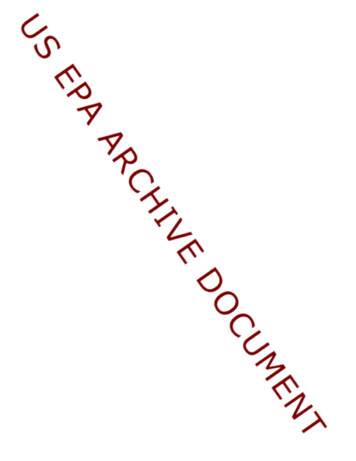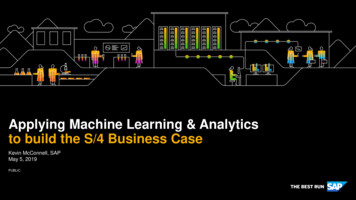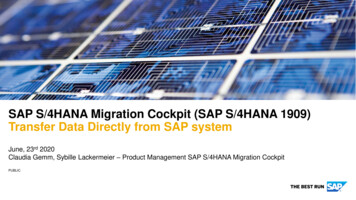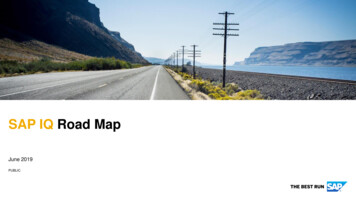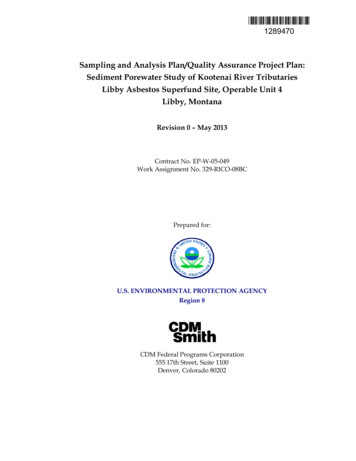
Transcription
*1289470*1289470Sampling and Analysis Plan/Quality Assurance Project Plan:Sediment Porewater Study of Kootenai River TributariesLibby Asbestos Superfund Site, Operable Unit 4Libby, MontanaRevision 0 – May 2013Contract No. EP-W-05-049Work Assignment No. 329-RICO-08BCPrepared for:U.S. ENVIRONMENTAL PROTECTION AGENCYRegion 8CDM Federal Programs Corporation555 17th Street, Suite 1100Denver, Colorado 80202
This page intentionally left blank to facilitate double-sided printing.SAP/QAPP: Tributary Sediment PorewaterRevision 0 – May 2013Page 2 of 59
This page intentionally left blank to facilitate double-sided printing.SAP/QAPP: Tributary Sediment PorewaterRevision 0 – May 2013Page 4 of 59
Table of ContentsA3.Distribution List .11A4.Project Task Organization .12A4.1Project Management. 12A4.2Technical Support. 12A4.2.1 SAP/QAPP Development . 12A4.2.2 Field Sampling Activities. 13A4.2.3 Asbestos Analysis . 13A4.2.4 Data Management . 13A4.3Quality Assurance . 14A5.Problem Definition/Background .14A5.1A5.2A5.3A6.Project/Task Description .16A6.1A6.2A6.3A6.4A7.Task Summary . 16Work Schedule . 16Locations to be Evaluated. 17Resources and Time Constraints . 17Quality Objectives and Criteria.17A7.1A7.2A7.3A7.4A7.5A7.6A7.7A8.Site Background . 14Reasons for this Project . 15Applicable Criteria and Action Limits . 15Data Quality Objectives . 17Performance Criteria . 17Precision . 18Bias and Representativeness . 18Completeness . 18Comparability . 18Method Sensitivity . 19Special Training/Certifications.19A8.1Field . 19A8.2Laboratory . 20A8.2.1 Certifications . 20A8.2.2 Laboratory Team Training/Mentoring Program . 20A8.2.3 Analyst Training . 22A9.Documentation and Records .23B1.Study Design .25B1.1B1.2B1.3B1.4B1.5Sampling Locations . 25Sampling Schedule. 25Study Variables . 26Critical Measurements . 26Data Reduction and Interpretation . 26SAP/QAPP: Tributary Sediment PorewaterRevision 0 – May 2013Page 5 of 59
B1.5.1 Sediment Porewater and Surface Water . 26B1.5.2 Sediment . 27B2.Sampling Methods .27B2.1Sample Collection. 27B2.1.1 Sediment Porewater . 27B2.1.2 Surface Water . 28B2.1.3 Sediment . 28B2.2Global Positioning System Coordinate Collection . 29B2.3Equipment Decontamination . 29B2.4Handling Investigation-derived Waste . 29B3.Sample Handling and Custody .29B3.1Sample Identification and Documentation . 29B3.1.1 Sample Labels . 29B3.1.2 Field Sample Data Sheets . 30B3.1.3 Field Logbooks . 31B3.2Field Sample Custody . 31B3.3Chain-of-Custody Requirements . 31B3.4Sample Packaging and Shipping . 32B3.5Holding Times. 33B3.6Archival and Final Disposition . 33B4.Analytical Methods .33B4.1Analysis of LA in Water . 33B4.1.1 Sample Preparation . 33B4.1.2 Analysis Method. 34B4.1.3 Counting Rules. 34B4.2Analysis of LA in Sediment . 34B4.2.1 Sample Preparation . 34B4.2.2 Analysis Method. 35B4.3Analytical Data Reports. 35B4.4Laboratory Data Reporting Tools . 35B4.5Analytical Turn-around Time . 36B4.6Custody Procedures . 36B5.Quality Assurance/Quality Control .37B5.1Field . 37B5.1.1 Training. 37B5.1.2 Modification Documentation . 37B5.1.3 Field Surveillances . 38B5.1.4 Field Audits . 38B5.1.5 Field QC Samples . 38B5.2Preparation Laboratory . 40B5.2.1 Training/Certifications . 40B5.2.2 Modification Documentation . 40B5.2.3 Soil Preparation Facility Audits. 41SAP/QAPP: Tributary Sediment PorewaterRevision 0 – May 2013Page 6 of 59
B5.2.4 Preparation QC Samples . 41B5.2.5 Performance Evaluation Standards. 43B5.3Analytical Laboratory . 44B5.3.1 Training/Certifications . 44B5.3.2 Modification Documentation . 44B5.3.3 Laboratory Audits . 45B5.3.4 Laboratory QC Analyses. 46B6/B7.Instrument Maintenance and Calibration .47B6/B7.1 Field Equipment . 47B6/B7.2 Laboratory Instruments . 47B8.Inspection/Acceptance of Supplies and Consumables .47B8.1B8.2Field . 47Laboratory . 48B9.Non-Direct Measurements .48B10.Data Management .48B10.1B10.2B10.3B10.4B10.5Field Data Management . 48Troy SPF Data Management . 49Analytical Laboratory Data Management . 49Libby Project Database . 49Data Reporting . 50C1. Assessment and Response Actions .51C1.1C1.2Assessments . 51Response Actions. 51C2. Reports to Management .51D1/D2. Data Review, Verification and Validation .53D1,D2.1D1/D2.2D1/D2.3D1/D2.4D3.Data Review. 53Criteria for LA Measurement Acceptability . 53Data Verification Method . 54Data Validation Method . 55Reconciliation with User Requirements .56References.57SAP/QAPP: Tributary Sediment PorewaterRevision 0 – May 2013Page 7 of 59
List of FiguresFigure A-1Figure B-1Figure B-2Figure B-3Figure B-4Figure B-5Organizational Chart for the Tributary Porewater StudyLibby Sediment Porewater Sampling LocationsTroy Sediment Porewater Sampling LocationsMeasured Porewater Concentrations in the 2012 Eyed Egg StudyMeasured Surface Water Flows in OU3 CreeksExample Photos of Porewater Sampling using Modified Whitlock Vibert BoxesList of TablesTable B-1Table D-1Sampling Location DescriptionsGeneral Evaluation Methods for Assessing Asbestos Data UsabilityList of AppendicesAppendix AAppendix BAppendix CData Quality Objectives (DQOs) for Sediment PorewaterStandard Operating ProceduresAnalytical Requirements Summary Sheet [PWTBOU4-0513]SAP/QAPP: Tributary Sediment PorewaterRevision 0 – May 2013Page 8 of 59
List of Acronyms and AbbreviationsAgoAPPASTMCARBCB&ICDM SmithCERCLACHISQCOCCwDE GPSH&SHAZWOPERHDPEIDIDWKDCLLALADTLCLRCMFLmm2Narea of a grid openingAccident Prevention PlanAmerican Society of Testing and MaterialsCalifornia Air Resources BoardCB&I Federal Services, LLCCDM Federal Programs CorporationComprehensive Environmental Response, Compensation, and Liability Actchi-squaredchain-of-custodywater concentrationdata entry toolMontana Department of Environmental Qualitydata quality objectiveelectronic data deliverableEnergy Dispersive Spectroscopyeffective filter areaeffect levelU.S. Environmental Protection AgencyEnvironmental Response TeamEnvironmental Services Assistance Teamfibers per literfield sample data sheetfield team leaderFish Wildlife and Parksgeographic information systemnumber of grid openings examinedglobal positioning systemhealth and safetyHazardous Waste Operations and Emergency Responsehigh-density polyethyleneidentificationinvestigation-derived wasteKootenai Development CorporationlitersLibby amphiboleLibby Asbestos Data Toollaboratory coordinatorlower Rainy Creekmillion fibers per litersquare millimetersnumber of asbestos structures countedSAP/QAPP: Tributary Sediment PorewaterRevision 0 – May 2013Page 9 of 59
USGSUVVWVBnon-detectno-effect levelNational Functional GuidelinesNational Institute for Occupational Safety and HealthNational Institute of Standards and TechnologyNational Voluntary Laboratory Accreditation ProgramOccupational Safety and Health AdministrationOperable Unitperformance evaluationpolarized light microscopypolarized light microscopy visual area estimationpolarized light microscopy gravimetricProject Managerquality assuranceQuality Assurance Managerquality assurance project planQuality Assurance Technical Supportquality controlRemedial Action Contractrecord of modificationRegional Project Managersampling and analysis planLibby Asbestos Superfund SiteSample Preparation Facilitystandard operating procedurestandard reference materialtransmission electron microscopymicrometersUnited States Fish and Wildlife ServiceU.S. Geological Surveyultravioletvolume of water applied to the filterWhitlock Vibert BoxSAP/QAPP: Tributary Sediment PorewaterRevision 0 – May 2013Page 10 of 59
AProject ManagementA3.Distribution ListCopies of this completed/signed sampling and analysis plan/quality assurance project plan(SAP/QAPP) should be distributed to:U.S. Environmental Protection Agency, Region VIII1595 Wynkoop StreetDenver, Colorado 80202-1129- Rebecca Thomas, Thomas.Rebecca@epa.gov (1 hard copy, 1 electronic copy)- Elizabeth Fagen, Fagen.Elizabeth@epa.gov (1 electronic copy)- Dan Wall, Wall.Dan@epa.gov (1 electronic copy)- Dania Zinner, Zinner.Dania@epa.gov (1 electronic copy)- Don Goodrich, Goodrich.Donald@epa.gov (1 electronic copy)- Jeff Mosal, Mosal.Jeffrey@epa.gov (1 electronic copy)EPA Information Center – Libby108 E 9th StreetLibby, Montana 59923- Mike Cirian, Cirian.Mike@epa.gov (1 hard copy, 1 electronic copy)Montana Department of Environmental Quality (DEQ)1100 N Last Chance GulchHelena, Montana 59601- Carolyn Rutland, CRutland@mt.gov (1 electronic copy)Environmental Services Assistance Team (ESAT), Region 8TechLaw, Inc.16194 W 45th DriveGolden, Colorado 80403- Doug Kent, Kent.Doug@epa.gov (1 electronic copy)Quality Assurance Technical Support (QATS)Shaw Environmental & Infrastructure Group20 George StreetCambridge, Massachusetts 02140- Mike Lenkauskas, Michael.Lenkauskas@shawgrp.com (1 electronic copy)CDM Smith – Libby Field Office60 Port Boulevard, Suite 201Libby, Montana 59923- Dominic Pisciotta, pisciottadm@cdmsmith.com (3 hard copies, 1 electronic copy)- Terry Crowell, crowellTL@cdmsmith.com (electronic copy)- Damon Repine, repineDL@cdmsmith.com (electronic copy)SAP/QAPP: Tributary Sediment PorewaterRevision 0 – May 2013Page 11 of 59
CDM Smith – Denver Office555 17th Street, Suite 1100Denver, Colorado 80202- Nathan Smith, smithNT@cdmsmith.com (electronic copy)Copies of this SAP/QAPP will be distributed to the individuals above by CDM FederalPrograms Corporation (CDM Smith), either in hard copy or in electronic format (as indicatedabove). The CDM Smith Project Manager (or their designee) will distribute updated copies eachtime a SAP/QAPP revision occurs.A4.Project Task OrganizationFigure A-1 presents an organizational chart that shows lines of authority and reportingresponsibilities for this project. The following sections summarize the entities and individualsthat will be responsible for providing project management, technical support, and qualityassurance (QA) for this project.A4.1 Project ManagementThe U.S. Environmental Protection Agency (EPA) is the lead regulatory agency for Superfundactivities within the Libby Asbestos Superfund Site (Site). The EPA Region 8 Libby AsbestosProject Team Leader is Rebecca Thomas. The EPA Regional Project Manager (RPM) for thissampling effort is Elizabeth Fagen. The EPA Region 8 Onsite RPM for this sampling effort isMike Cirian.The Montana Department of Environmental Quality (DEQ) is the support regulatory agency forSuperfund activities at the Site. The DEQ Project Manager (PM) for this sampling effort isCarolyn Rutland. The EPA will consult with DEQ as provided for by the ComprehensiveEnvironmental Response, Compensation, and Liability Act (CERCLA), the NationalContingency Plan, and applicable guidance in conducting Superfund activities.A4.2 Technical SupportA4.2.1 SAP/QAPP DevelopmentThis SAP/QAPP was developed by CDM Smith at the direction of and with oversight by theEPA. This SAP/QAPP contains all the elements required for both a SAP and a QAPP and hasbeen developed in general accordance with the EPA Requirements for Quality Assurance ProjectPlans, EPA QA/R-5 (EPA 2001) and the Guidance on Systematic Planning Using the Data QualityObjectives Process, EPA QA/G4 (EPA 2006). This SAP/QAPP was prepared and field activitieswill be performed under the Remedial Action Contract (RAC), Contract No. EP-W-05-049, WorkAssignment No. 329-RICO-08BC. As noted above, the CDM Smith Project Manager (or theirdesignee) is responsible for distributing updated copies of the SAP/QAPP if a revision occurs.SAP/QAPP: Tributary Sediment PorewaterRevision 0 – May 2013Page 12 of 59
A4.2.2 Field Sampling ActivitiesCDM Smith will also be responsible for conducting all field sampling activities in support of thesampling program described in this SAP/QAPP. Key CDM Smith personnel that will beinvolved in this sampling program include: Nathan Smith, Project ManagerDominic Pisciotta, Field Team LeaderTracy Dodge, Field Sample CoordinatorDiane Rode, Field Data ManagerTerry Crowell, Quality Assurance CoordinatorDamon Repine, Health and Safety ManagerA4.2.3 Asbestos AnalysisAll samples of sediment porewater, surface water, and sediment collected as part of this projectwill be sent for preparation and analysis for asbestos at laboratories selected and approved bythe EPA to support the Site. The EPA Environmental Services Assistance Team (ESAT) isresponsible for procuring all analytical and preparation laboratory services and providingdirection to the analytical laboratories. Don Goodrich (EPA Region 8) is responsible formanaging the ESAT laboratory support contract for asbestos. The ESAT Region 8 TeamManager at TechLaw, Inc. is Mark McDaniel. He is also the designated laboratory coordinator(LC) for the Libby project that is responsible for directing the analytical laboratories, prioritizinganalysis needs, and managing laboratory capacity.A4.2.4 Data ManagementAll data generated as part of this sampling effort will be managed and maintained in Scribe.The EPA Environmental Response Team (ERT) is responsible for the administration of all Scribedata management aspects of this project. Joseph Schafer is responsible for overseeing the ERTdata management support contract. ERT is responsible for the development and management ofScribe and the project-specific data reporting requirements for the Libby project.The CDM Smith field data manager (Diane Rode) is responsible for uploading sampleinformation to the field Scribe project database. ESAT is responsible for uploading newanalytical results to the analytical Scribe project database. The ESAT project data manager forthe Libby project is Janelle Lohman (TechLaw, Inc.).SAP/QAPP: Tributary Sediment PorewaterRevision 0 – May 2013Page 13 of 59
A4.3 Quality AssuranceThere is no individual designated as the EPA Quality Assurance Manager for the Libby project.Rather, for SAP/QAPPs prepared under the RAC, the Region 8 QA program has delegatedauthority to the EPA RPMs for the Site. This means that the EPA RPMs have the ability toreview and approve governing investigation documents developed by Site contractors. It is theresponsibility of the designated EPA Quality Assurance Reviewer (Dania Zinner), who isindependent of the entities planning and obtaining the data, to ensure that this SAP/QAPP hasbeen prepared in accordance with the EPA QA guidelines and requirements. The EPA RPM isresponsible for managing and overseeing all aspects of the quality assurance/quality control(QA/QC) program for this sampling effort. In this regard, the RPM is supported by the EPAQuality Assurance Technical Support (QATS) contractor, CB&I Federal Services, LLC (CB&I).The QATS contractor will evaluate and monitor laboratory QA/QC and is responsible forperforming annual audits of each preparation and analytical laboratory.Terry Crowell (CDM Smith) is the field QA Coordinator for this project. Ms. Crowell isresponsible for evaluating and monitoring field QA/QC, for providing oversight of fieldsampling and data collection activities, and for designating a qualified individual to conduct thefield audit (see Section C1.1).A5.Problem Definition/BackgroundA5.1 Site BackgroundLibby is a community in northwestern Montana located seven miles southwest of a vermiculitemine that operated from the 1920s until 1990. The mine began limited operations in the 1920sand was operated on a larger scale by the W.R. Grace Company from approximately 1963 to1990. Studies revealed that the vermiculite from the mine contains amphibole-type asbestos,referred to as Libby amphibole (LA).Epidemiological studies revealed that workers at the mine had an increased risk of developingasbestos-related lung disease (McDonald et al. 1986, 2004; Amandus and Wheeler 1987;Amandus et al. 1987; Whitehouse 2004; Sullivan 2007). Additionally, radiographic abnormalitieswere observed in 17.8 percent (%) of the general population of Libby including former workers,family members of workers, and individuals with no specific pathway of exposure (Peipins etal. 2003; Whitehouse et al. 2008; Antao et al. 2012; Larsen et al. 2010, 2012a, 2012b). Although themine has ceased operations, historic or continuing releases of LA from mine-related materialscould be serving as a source of ongoing exposure and risk to current and future residents andworkers in the area. The Site was listed on the EPA National Priorities List in October 2002.Previous investigations conducted at the Site have demonstrated that LA is present inenvironmental source media (e.g., surface water, sediments) at locations in and around the Site.SAP/QAPP: Tributary Sediment PorewaterRevision 0 – May 2013Page 14 of 59
High levels of LA have been measured in surface water and sediment in lower Rainy Creek(LRC) (EPA 2009). In addition, a recent sampling effort determined the presence of LA insurface water and/or sediment of the Kootenai River and several of its tributaries (EPA 2013b).The presence of LA in these aquatic media has the potential to adversely impact ecologicalreceptors that inhabit these rivers and creeks.A5.2 Reasons for this ProjectIn 2012, contractors for W.R. Grace & Co.-Conn. and the Kootenai Development Corporation(KDC) performed an in-stream caged fish (eyed egg and alevin) study to provide informationon potential effects of exposures in LRC to trout (EPA 2012a). Eggs and pre-swim-up alevinsreside in the stream gravel, so the exposure medium of chief concern is the gravel porewater.Results from this study demonstrated that measured gravel (sediment) porewaterconcentrations of LA were much higher than the overlying surface water concentrations (SRC,Inc. 2013). Results from this study also suggested that there might be a decrease in overallsurvival of trout in LRC, but these results were considered to have low reliability due severalstudy limitations (SRC, Inc. 2013). Due to these limitations, the in-stream eyed egg study will berepeated in 2013, modifying the study design and protocol to address the issues that occurredduring the 2012 study (EPA 2013a). It is expected that this study will be used to identify an LAconcentration in sediment porewater that is a no-effect level (NEL) and/or an effect level (EL),depending upon the study outcome.This SAP/QAPP describes the sampling program to collect sediment porewater samples fromtributaries to the Kootenai River. These porewater samples will be analyzed for LA and themeasured porewater LA concentrations will be compared to the NEL and/or the EL levels (asestablished by the results of the 2013 in-stream eyed egg study) to determine the potential forLA effects on fish in an ecological risk assessment. The measured porewater LA concentrationswill also be used to characterize the nature and extent of LA in porewater at the Site. Detailedinformation on the study design is presented in Section B1.A5.3 Applicable Criteria and Action LimitsThere are no established criteria to evaluate ecological risk from exposures to LA. A review ofavailable ecological toxicity data for asbestos in the literature reveals that it appears that effectsthresholds for freshwater fish range from about 10,000-1,000,000 fibers per liter (f/L) in surfacewater.Aquatic invertebrate sediment toxicity tests performed using sediment from Operable Unit 3(OU3) at levels of up to 5% LA in sediment revealed that no adverse effects on survival, growth,or reproduction occurred in exposed aquatic invertebrates (Parametrix 2009a, 2009b).SAP/QAPP: Tributary Sediment PorewaterRevision 0 – May 2013Page 15 of 59
Currently, there are no studies that provide information on effects thresholds for LA insediment porewater. However, it is expected that the 2013 in-stream eyed egg study in LRC willprovide an NEL and /or EL that can be used to evaluate potential risks to fish from exposuresto LA in sediment porewater.A6.Project/Task DescriptionA6.1 Task SummaryThe basic tasks that are required to implement this SAP/QAPP are the collection of porewatersamples for the same Kootenai River tributary creeks sampled in 2012 as part of the Nature andExtent Study in Surface Water and Sediment (EPA 2012b), with the addition of three samplinglocations (two in O’Brien Creek and one in Fisher River). To ensure comparability, theporewater samples collected as part of this study will be collected using the same collectiontechniques that will be used to collect porewater during the 2013 in-stream eyed egg study inLRC (EPA 2013a). At the three new sampling locations in O’Brien Creek and Fisher River,surface water and sediment samples will also be collected. Sediment porewater, surface water,and sediment samples will be analyzed for LA.A6.2 Work ScheduleAs noted above, sediment porewater will be collected using the same sampling procedures aswill be used in the 2013 in-stream eyed egg study in LRC (EPA 2013a). In brief, porewater willbe collected from inside the chamber of a Whitlock-Vibert box (WVB) that has been buried inthe stream channel. WVBs will be placed during the peak or falling limb of the hydrograph,which is expected to occur about mid-May. Actual sampling times may vary depending uponsite conditions. Wor
EPA. This SAP/QAPP contains all the elements required for both a SAP and a QAPP and has been developed in general accordance with the EPA Requirements for Quality Assurance Project Plans, EPA QA/R-5 (EPA 2001) and the Guidance on Systematic Planning Using the Data Quality Objectives Process, EPA QA/G4 (EPA 2006). This SAP/QAPP was prepared and .


